

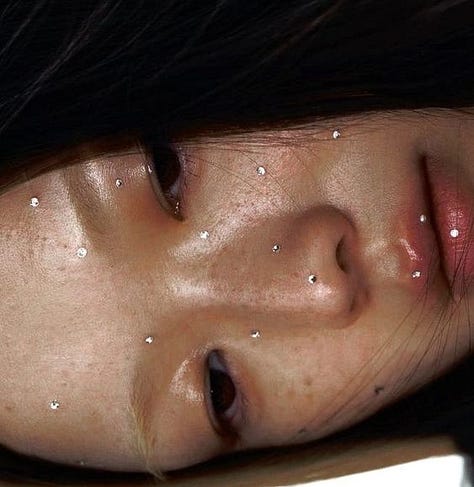
Hello soft glow readers! Happy new year. Do you feel fresh, like a new version of you, ready for a clean start? While mindset work like that is certainly helpful, I just wrote a piece about purity ideologies - so I’m still seeing everything through a cultural lens on purity. Purity rhetoric can be far more complicated than it appears. I’ll be talking about clean girl aesthetics, Rudolf Steiner ideologies, raw meat diets, Weleda’s troubling past, white supremacy, tradwives and of course clean beauty. It will soon be published on my personal substack. If you like a bit of a cultural deep dive on pop culture/psychology/politics but also enjoy reading more vulnerable diary entries, make sure to subscribe. <3
We’ll start this letter with a classic, stream of consciousness, in and out list for beauty, including an overview of products to carry with us into 2025. But I also want to shine a light on the misleading marketing tactics of beauty brands and clinics. One of the most convincing and converting marketing tools are before and after pictures.
As someone with a background in photography, I can recognise when these images have been manipulated to create unrealistic expectations. In many cases, the photos are edited or taken under carefully controlled conditions designed to exaggerate the results.
In this letter, I’ll share examples of these tactics and guide you on how to spot the tell-tale signs of photo manipulation. My ultimate goal with Soft Glow is to empower you to make informed beauty decisions, helping you approach products and treatments with a critical eye, but without unnecessary fear or scepticism.
Thank you for being here! <3

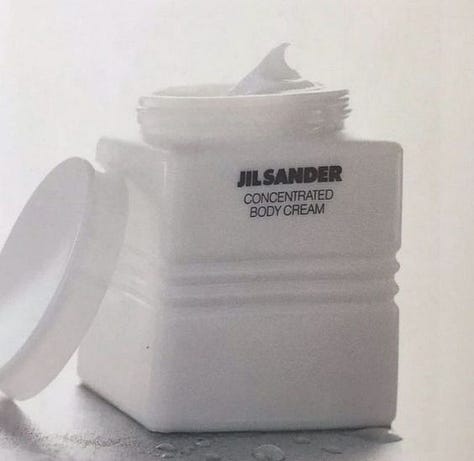
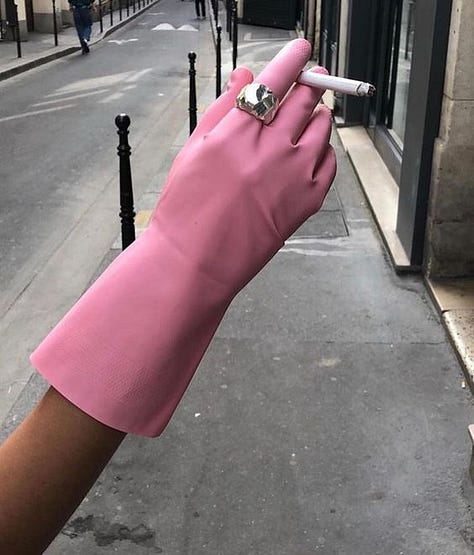
in for 2025
science-first body care products
topical growth factors
the dose makes the poison>clean beauty
simplified skincare routines during the week with suuuper extra extensive 20 step rituals in the weekends
hand SPF
stretching Botox appointments from having 3-4 months in between appointments, to many months longer and/or switching to Baby Botox for a softer, more natural look is having a major growth moment. Blame it on the rise of lasers and radiofrequency treatments among the under-40 set, the growing trend of preventative facelifts in younger age groups or our obsession with pre-2000’s movies and series. Either way, a little movement in the face is officially back in style!
extensive body care rituals, ritualising routines in general
eating your veggies, fruits, fermented foods, nuts and yes, seed oils
handcare routines
fascia massage
buying less and better
skincare infused make-up - I think it will be hard to find make-up without skincare in there pretty soon, but I also think there is still a big opportunity for innovation there
triple fact checking stuff before you create content about it(!!)
inviting the right experts for your articles on beauty. skincare products? you need product developers, chemists and toxicologists. not dermatologists. medical skin issues? you need dermatologists. legislation / skincare safety? you need toxicologists. for more light and fun journalism you can ask people with lesser academic skin expertise like marketing people and aestheticians.
1-3x a week exfoliating in stead of 1-2 times a day
shower filters against hair breakage
nivea blue jar for hands or just cuticles
face mists
coloured lenses
cold tone make up
taking tiktok advice with a grain of salt, even from dermatologists and aestheticians
full life cycle assessments for products
clip in extensions
we can take these products with us in 2025:
Medik8 crystal retinal, tower28 hypochlorus acid spray, tower28 sos lip balm, diptyque l’eau papier, k18 hair mask, medicube deep vita c capsule cream, the ordinary retinal 0,2% emulsion, i’m from honey mask, rare beauty always an optimist prep and set mist, u beauty the super tinted hydrator, ultra violette reapplication mist spf50, cerave hydrating cream to foam cleanser, aesop hand sanitiser, MAC plump gloss, toboco bio watery sun cream spf50, Necessaire soap blocks, neck stretcher as antidote to iphone posture.
here’s a list containing more favourite products that I’ll definitely rebuy in 2025.
out for 2025
brands and clinics photoshopping before and after pictures
ingredient-led marketing, or demonising ingredients by only reading the ingredients list, denying the dose makes the poison and the fact that toxicologists take accumulation into consideration, and not trying the formula or reading the clinical trials and safety assessments on the formula
clean girl aesthetic
thick moisturisers that take a while to soak in (we live in a world with modern, innovative formula’s that can de super light but deeply hydrating)
chemofobia
obsessing over sex & the city, it will forever have a place in my heart but we talked too much about it in 2024
perfectionism
spreading fear marketing and misinformation on skincare in order to sell your “clean” / “natural” products
thinking the EWG is a reliable source. - they are a literal lobby spreading misinformation for their agenda, they use outdated-, poorly done- or debunked studies for their sensationalist claims. not scientific.
cigarettes
focusing on demonising synthetic endocrine disruptors while ignoring naturally derived endocrine disruptors like Lavender oil. Again: not focusing on the fact that the dose makes the poison
press on nails - i’m sorry but the healthy-for-nails gummy clay goo doesn’t last longer than an evening and when you want the nails for 2 weeks they tell you to opt for literal 1 second glue in stead? That’s not innovation that’s regression. As always, I am open to be convinced otherwise
B corp - these days everyone seems to be able to become B corp? I used to work for a tech startup that wanted to become B corp and learned that you can basically cheat one section like climate change reduction by focusing on how you treat your staff in stead. Isn’t it giving… greenwashing??
believing reading ingredients lists = more important than formula, clinical trials and reviews
skin supplements - the supplement industry is wildly unregulated, unlike the skincare industry or the pharmaceutical industry, but somehow people looove trusting supplements over perfectly safe skincare, food or medicine. Don’t get me wrong, there are some great supplements out there. I’m just saying that the brands do not have to test their formula’s to make wild(!) health claims, just be very careful and do your research.
misinformation about seed oils, about raw animal derived diets, about most veggies being “toxic” (lol)
blindly believing non-experts on tiktok on skincare advice or any health advice for that matter. The classic media advertising industry is wildly regulated (you can’t just say a product will help “balance your hormones” for example, on a tv or bus ad.) but influencer marketing is mostly unregulated in practice. They can say anything without real consequence, only adding to consumer confusion and overwhelm. My prediction is that this will change soon, and I think that would be great.
greenwashing. sadly most brands do this, but it is also a little bit of a challenge not to since there are no simple standards and regulations for sustainability practices. it is a complex realm. However, brands need to do better. If they would really wanted to, they could fix their wording and marketing easily and imo they should allocate more money towards full life cycle assessments or other sustainability practices.
hyaluronic acid serums (the ingredient is to be found in all your other skincare)
niacinamide serums (the ingredient is to be found in almost all your other skincare)
thinking clean beauty is scientific
being married to 15 steps every morning and evening
not using sunscreen. In some circles there was a misinformed return to baking in the sun without sunscreen in the past year. sun is nice, but also dangerous. you are not a battery that needs to be charged by the sun. nor is your vulva.
The truth behind before and after marketing
Before-and-after photos have this undeniable allure. They feel real, untouched, and relatable. Nothing like the glossy perfection of a studio shoot. There’s no professional lighting or heavy retouching, just the promise of raw honesty. At least, that’s what they want you to believe.
The reality is a bit different. Many clinics and brands quietly tweak these images to create dramatic, almost-too-good-to-be-true transformations. A shift in lighting here, a subtle touch of Photoshop there, and suddenly the results look far more impressive than they really are. It’s all designed to sell you on a fantasy: the idea that one treatment, product, or procedure can deliver flawless, instant results.
This isn’t to say that skincare and treatments can’t deliver amazing results. But they deserve to be judged on their own merit, not through a filter of manipulated images. Honesty shouldn’t feel revolutionary, but here we are.
So I wanna start by showcasing something the most used tactic: using a brighter light or brightening the after photo with photo editing software. In this case you can see it by looking at the shadow at the subject’s eye, which is way more prominent in the before picture. The best way to see it usually is by looking at the white of the eyes and comparing warmth and brightness of the eyewhites. You can do the same by comparing white backgrounds if they are in the picture.
This tactic takes things up a notch: using blurring tools in editing software to smooth out the skin. A good trick is to check for consistent details like pores, birthmarks, or fine hairs - they should maintain the same sharpness and colour in both the before- and after photos. In this example, even the fine hairs have been blurred out, which would be quite the miracle if a skincare product could pull that off. Definitely a red flag.
Then I want to share another one, there is a chance that her Post Inflammatory Hyperpigmentation has actually brightened, cause her skin looks way more healthy overall. That being said, either the light conditions are different or someone edited the light in the picture. Which makes me suspect that they might have zapped some spots away with an editing programme (or maybe their customer did, since this was a customer at home and not a subject in a clinical trial). For the change in light, you can compare her irises in both pictures:
I want to give you some more before and afters to play with, so you can train your eye. One if from a brand I adore so I wanted to make the subject anonymous.
One of these examples seems like a legit before and after to me. Can you tell which one it is?
Thank you for being here with me, it means the world. If you find extremely edited before and after pictures, or if you’re not sure to believe the ones from your favourite brand, feel free to message me wherever <3
Make sure to follow me on instagram for skin tips, grwm’s, BS marketing debunking and make-up inspiration.
xoxo
Soft Glow






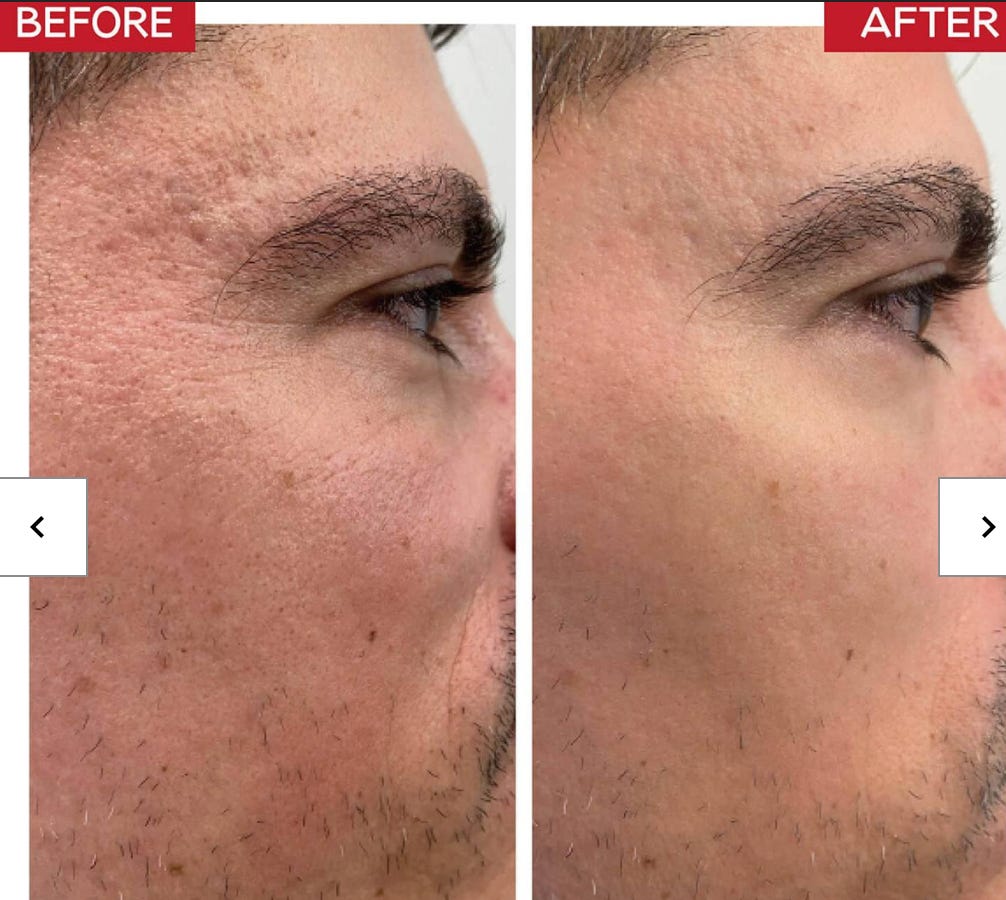
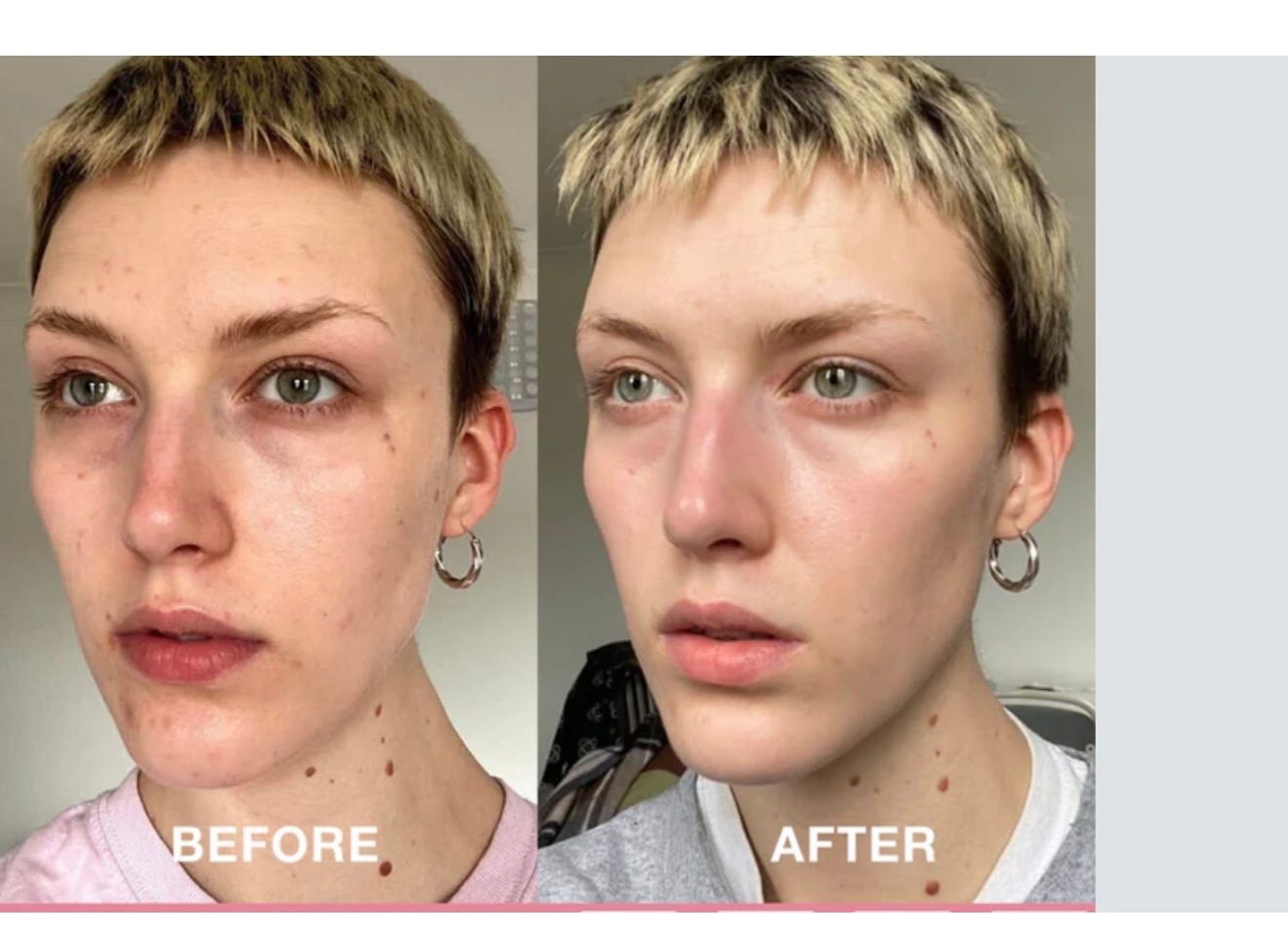

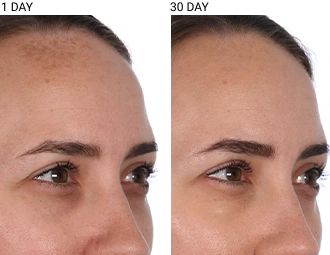
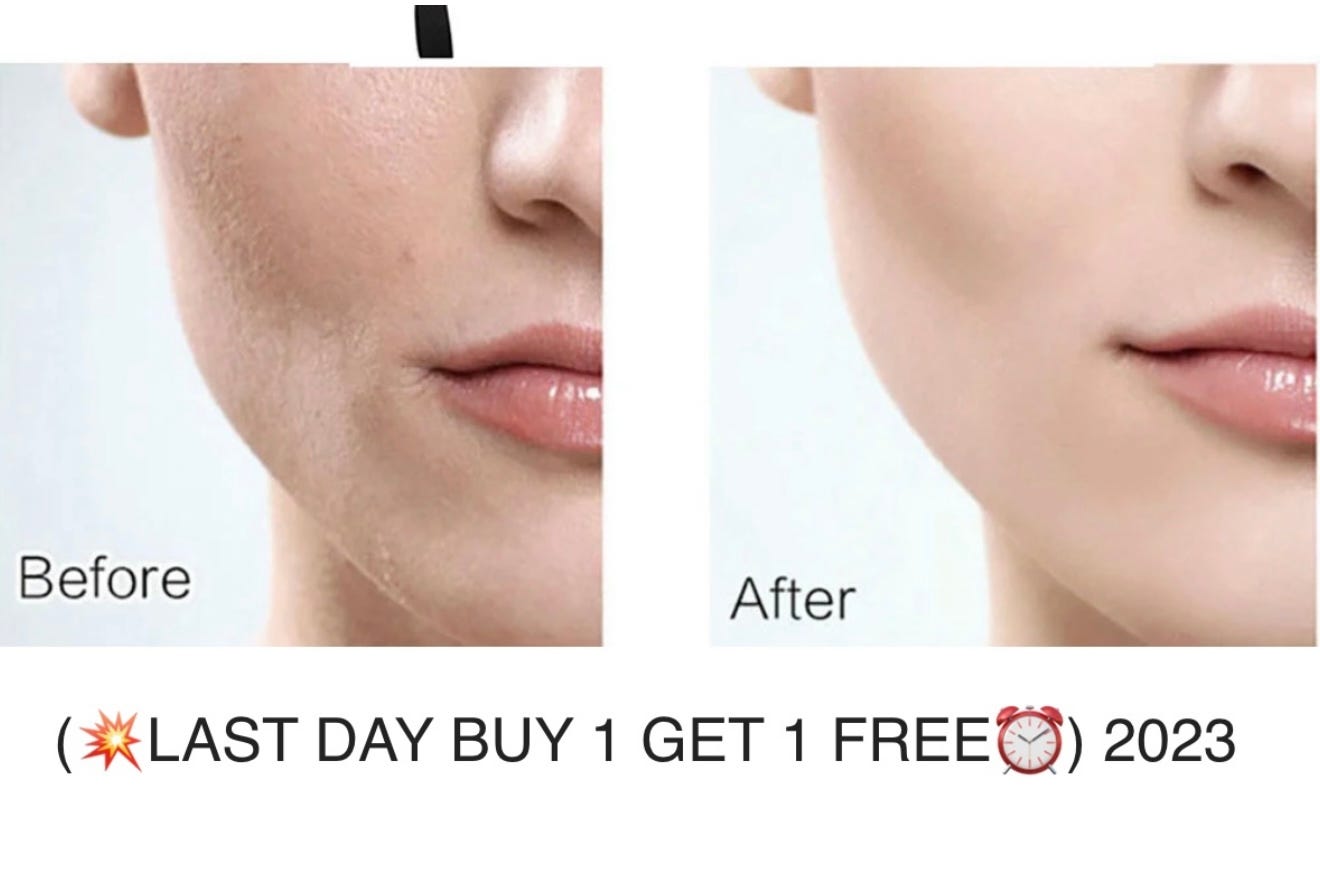
May I add, IN: while botox is still on the rise without any sign of stopping (except way of use is changing as talked about in the article) - people will opt less and less for dermal fillers, and more often for lasers & radiofrequency (and yes face lifts).
OUT though: Morpheus 8, too many error stories. Although the blame lies with the people operating the machine. Be so very careful with choosing the right clinic! And don't opt for aestheticians operating any heat devices. Go for dermatologists or skin specialists with at least 4 years of high quality training. Types of quality certifications will depend on the country the clinic is operating in.
IN: cosmetic tourism: going to Seoul for skin treatments.
OUT: blindly trusting every local skin expert / aesthetician / dermatologist
the 👏 EWG 👏 is 👏 a 👏 scam 👏 xoxo a cosmetic chemist